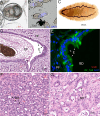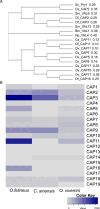Similarities and differences among the Opisthorchiidae liver flukes: insights from Opisthorchis felineus
- PMID: 35570685
- PMCID: PMC11010525
- DOI: 10.1017/S0031182022000397
Similarities and differences among the Opisthorchiidae liver flukes: insights from Opisthorchis felineus
Abstract
The foodborne liver trematode Opisthorchis felineus (Rivolta, 1884) is a member of the triad of phylogenetically related epidemiologically important Opisthorchiidae trematodes, which also includes O. viverrini (Poirier, 1886) and Clonorchis sinensis (Loos, 1907). Despite similarity in the life cycle, Opisthorchiidae liver flukes also have marked differences. Two species (O. viverrini and C. sinensis) are recognized as Group 1A biological carcinogens, whereas O. felineus belongs to Group 3A. In this review, we focus on these questions: Are there actual differences in carcinogenicity among these 3 liver fluke species? Is there an explanation for these differences? We provide a recent update of our knowledge on the liver fluke O. felineus and highlight its differences from O. viverrini and C. sinensis. In particular, we concentrate on differences in the climate of endemic areas, characteristics of the life cycle, the range of intermediate hosts, genomic and transcriptomic features of the pathogens, and clinical symptoms and morbidity of the infections in humans. The discussion of these questions can stimulate new developments in comparative studies on the pathogenicity of liver flukes and should help to identify species-specific features of opisthorchiasis and clonorchiasis pathogenesis.
Keywords: Cholangiocarcinoma; Opisthorchis felineus; foodborne trematodes; liver flukes.
Conflict of interest statement
None.
Figures





Similar articles
-
Opisthorchis viverrini, Clonorchis sinensis and Opisthorchis felineus liver flukes affect mammalian host microbiome in a species-specific manner.PLoS Negl Trop Dis. 2023 Feb 13;17(2):e0011111. doi: 10.1371/journal.pntd.0011111. eCollection 2023 Feb. PLoS Negl Trop Dis. 2023. PMID: 36780567 Free PMC article.
-
New insights from Opisthorchis felineus genome: update on genomics of the epidemiologically important liver flukes.BMC Genomics. 2019 May 22;20(1):399. doi: 10.1186/s12864-019-5752-8. BMC Genomics. 2019. PMID: 31117933 Free PMC article.
-
Species-specific renal and liver responses during infection with food-borne trematodes Opisthorchis felineus, Opisthorchis viverrini, or Clonorchis sinensis.PLoS One. 2024 Dec 5;19(12):e0311481. doi: 10.1371/journal.pone.0311481. eCollection 2024. PLoS One. 2024. PMID: 39637122 Free PMC article.
-
The zoonotic, fish-borne liver flukes Clonorchis sinensis, Opisthorchis felineus and Opisthorchis viverrini.Int J Parasitol. 2013 Nov;43(12-13):1031-46. doi: 10.1016/j.ijpara.2013.07.007. Epub 2013 Aug 24. Int J Parasitol. 2013. PMID: 23978669 Review.
-
The liver fluke Opisthorchis felineus: biology, epidemiology and carcinogenic potential.Trans R Soc Trop Med Hyg. 2016 Jan;110(1):28-36. doi: 10.1093/trstmh/trv085. Trans R Soc Trop Med Hyg. 2016. PMID: 26740360 Review.
Cited by
-
Opisthorchis viverrini, Clonorchis sinensis and Opisthorchis felineus liver flukes affect mammalian host microbiome in a species-specific manner.PLoS Negl Trop Dis. 2023 Feb 13;17(2):e0011111. doi: 10.1371/journal.pntd.0011111. eCollection 2023 Feb. PLoS Negl Trop Dis. 2023. PMID: 36780567 Free PMC article.
-
Wound healing approach based on excretory-secretory product and lysate of liver flukes.Sci Rep. 2022 Dec 14;12(1):21639. doi: 10.1038/s41598-022-26275-y. Sci Rep. 2022. PMID: 36517588 Free PMC article.
-
Extracellular vesicles of the liver fluke Opisthorchis felineus stimulate the angiogenesis of human umbilical vein endothelial cells.Curr Res Parasitol Vector Borne Dis. 2023 Nov 7;4:100153. doi: 10.1016/j.crpvbd.2023.100153. eCollection 2023. Curr Res Parasitol Vector Borne Dis. 2023. PMID: 38045538 Free PMC article.
-
Genus Bithynia: morphological classification to molecular identification.Parasit Vectors. 2024 Nov 30;17(1):496. doi: 10.1186/s13071-024-06591-0. Parasit Vectors. 2024. PMID: 39616387 Free PMC article. Review.
-
The EGFR Signaling Pathway Is Involved in the Biliary Intraepithelial Neoplasia Associated with Liver Fluke Infection.Pathogens. 2025 Jun 21;14(7):620. doi: 10.3390/pathogens14070620. Pathogens. 2025. PMID: 40732668 Free PMC article.
References
-
- Arunsan P, Ittiprasert W, Smout MJ, Cochran CJ, Mann VH, Chaiyadet S, Karinshak SE, Sripa B, Young ND, Sotillo J, Loukas A, Brindley PJ and Laha T (2019) Programmed knockout mutation of liver fluke granulin attenuates virulence of infection-induced hepatobiliary morbidity. Elife 8, e41463. - PMC - PubMed
-
- Arunsan P, Chaidee A, Cochran CJ, Mann VH, Tanno T, Kumkhaek C, Smout MJ, Karinshak SE, Rodpai R, Sotillo J, Loukas A, Laha T, Brindley PJ and Ittiprasert W (2020) Liver fluke granulin promotes extracellular vesicle-mediated crosstalk and cellular microenvironment conducive to cholangiocarcinoma. Neoplasia 22, 203–216. - PMC - PubMed
-
- Aunpromma S, Kanjampa P, Papirom P, Tangkawattana S, Tangkawattana P, Tesana S, Boonmars T, Suwannatrai A, Uopsai S, Sukon P and Sripa B (2016) Prevalence and risk factors for Opisthorchis viverrini infection among cats and dogs in six districts surrounding the Ubolratana Dam, an endemic area for human opisthorchiasis in northeastern Thailand. Southeast Asian Journal of Tropical Medicine and Public Health 47, 1153–1159. - PubMed
-
- Bansal PS, Smout MJ, Wilson D, Cobos Caceres C, Dastpeyman M, Sotillo J, Seifert J, Brindley PJ, Loukas A and Daly NL (2017) Development of a potent wound healing agent based on the liver fluke granulin structural fold. Journal of Medicinal Chemistry 60, 4258–4266. - PubMed
-
- Bateman A, Cheung ST and Bennett HPJ (2018) A brief overview of progranulin in health and disease. Methods in Molecular Biology 1806, 3–15. - PubMed
Publication types
MeSH terms
LinkOut - more resources
Full Text Sources

